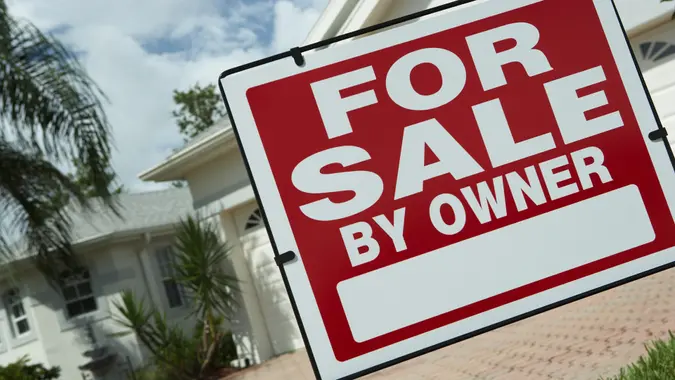I’m a Real Estate Expert: 4 Cities That Will Become More Affordable Under Trump

Commitment to Our Readers
GOBankingRates' editorial team is committed to bringing you unbiased reviews and information. We use data-driven methodologies to evaluate financial products and services - our reviews and ratings are not influenced by advertisers. You can read more about our editorial guidelines and our products and services review methodology.

20 Years
Helping You Live Richer

Reviewed
by Experts

Trusted by
Millions of Readers
Say what you think about the election and President-elect Donald Trump or Vice President Kamala Harris. The reality is that, regardless of your political affiliation, different presidents and their policies can dramatically affect areas of industry. Real estate, as one of the few industries that remains fairly consistent, is always going to be a hot topic when presidential administrations change.
What a Trump presidency looks like for real estate will obviously have a huge impact on how affordable, or unaffordable, it will be to live in different cities across the United States.
Typically, as real estate prices rise, the wealth of homeowners increases. Those homeowners are then more likely to borrow and spend money, which can lead to a boom in housing construction.
At the same time, as real estate becomes more expensive, low and middle-income people tend to find living expenses increasingly out of reach, especially in already expensive areas.
So, calling an area “affordable” can be tricky.
To help us understand how affordable cities might become, we’ve turned to an expert, Silvia Lupone, a financial advisor and housing market analyst at Stingray Villa. She’s spent years studying the link between economic policies and real estate trends in relation to the U.S. and broader North American housing market. We’ve also called in the expertise of Lyle Solomon at Oak View Law Group, a personal financial expert for over 30 years, to support Silvia’s expertise.
Here are the four cities they think will become more affordable under Trump.
St. Louis
St. Louis, a city buried deep in the Rust Belt, has been in decline for decades since the end of industrial factories.
In an attempt to turn things around, tariffs on some imports could “enhance competitiveness in the global setting. Such policies will create an incentive for people to migrate to the service-deprived areas, including the St. Louis Metro area, as they will offer them cost-effective housing and job opportunities.” Lupone told GOBankingRates.
Furthermore, Trump has promised to pass deregulation policies, especially in dying city centers, so that housing construction can thrive.
As Lupone said, the result of these policies and lowered taxes “might persuade certain businesses to locate elsewhere, which would generate local jobs and wages, and some housing demand.”
Cleveland
Cleveland is another city that has been notoriously low-income and economically depressed since the Industrial Age ended a few decades ago. But, according to Lupone, Trump’s tax policies may help turn that around.
In 2017, his administration passed the Tax Cuts and Jobs Act, which “majorly targeted the tax rates of companies and was also meant to enhance the economy of that region, which could have an indirect positive effect on the housing sector.”
With Trump back in office, this act, which was set to expire in 2025, will likely be extended and perhaps even enhanced. The policies within are designed to lower corporate taxes, which in turn should create more jobs because businesses that previously fled and other new businesses can now return to a safe tax haven and employ more people from the area.
These changes may see higher and higher wages for citizens of Cleveland, making housing and other goods more affordable.
Houston
Houston, a well-known energy hub in the United States, will likely benefit from Trump’s commitment to deregulate the energy sector, which is aimed at freeing up innovation and increasing the potential for wealth.
This move, if enacted, is sure to drive wealth up in Houston, enrich the people of the area and make housing more affordable.
As Lupone said, “The U.S. policies towards energy dependence and opening up of oil and gas reserves for exploration and development seemed to have contributed towards stabilizing the energy-based economy of Houston, which in turn resulted in a more stable housing market.”
And in the case of Houston, not only can we expect wages to rise, but we may also see prices decline. According to Lupone, “Increased oil production coupled with low environmental restrictions could lower the cost of energy and enable the economies of the cities to survive, potentially reducing living expenses, including prices on housing.”
And, as Solomon added, “Houston has already relaxed zoning laws and a development environment which promises space for the oil industry and gas businesses in a federal policy. This means the local economy is highly likely to stabilize because of housing costs becoming less volatile.”
These shifts may see Houston become simultaneously one of the wealthiest and most affordable regions in the country.
Phoenix
In an interesting shift, Lupone chose Phoenix as the fourth affordable city under the coming Trump administration. Why?
She points to immigration.
As she noted, Phoenix has been growing rapidly in population and wealth over the past several years, but one large problem has been the ongoing flow of migrants from the southern border, which Arizona shares with Mexico.
Historically, immigrants enter an area and need both housing and jobs.
With Trump’s strong stance on stemming the flow of immigrants into the United States from Mexico, we may see “the flow of immigrants decrease, and this could ease the pressure on the population of the Phoenix metro and give rise to relatively stable prices of housing.”
Essentially, fewer people in a thriving community would mean more housing and more jobs for those who remain.
To add to the highlights of Phoenix, Solomon looked to housing policies. As he noted, “Trump’s push for deregulation, especially in construction and housing, may remove zoning restrictions and enable lower building costs along Phoenix’s developing areas. Lands available for development under federal government policy could add to the housing supply and make it possible to meet increasing demands.”
Editor’s note on political coverage: GOBankingRates is nonpartisan and strives to cover all aspects of the economy objectively and present balanced reports on politically focused finance stories. You can find more coverage of this topic on GOBankingRates.com.
More From GOBankingRates
 Written by
Written by  Edited by
Edited by 

























